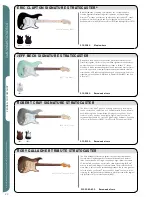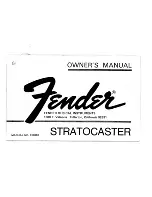
INSTRUCTION MANUAL
ELECTRIC GUITARS AND BASSES
BRIDGES
This is to certify that the aforementioned equipments fully conform to
protection requirements of the following EC council directives.
DIRECTIVES : 89/336/EEC Electromagnetic compatibility
Printed in JAPAN NOV00374 ©Copyright 2000
B A S S I N F O R M A T I O N
M A I N T E N A N C E
CLEANING
Regular cleaning of your guitar
is one the most important
ways you can maintain the
finish and lengthen string life.
After playing, wipe down your
instrument to remove any
perspiration from the
instrument. Perspiration can
actually contain acids that can
be corrosive to the strings and
metal parts of the guitar. Gloss finish guitars should be polished with
polish formulated specifically for musical instruments, and a soft, treated
guitar cloth or a cotton rag. Abrasive rags such as polyester can scratch
the finish. Oil finished guitars should be wiped clean immediately after
playing with a dry cotton rag only. If your guitar has become discolored
due to extended use or heavy perspiration, factory appearance, see a
qualified guitar repair person about methods to restore the oil finish to
its original factory appearance.
STRINGS AND TUNING MACHINES
If strings become dirty,
discolored, or produce a dull
sound or buzz, replace the
strings with new ones. For best
results we recommend replacing
one string at a time, this will
help to avoid removing the string
tension from the neck. When
replacing strings with different
gauge strings, it may be
necessary to adjust the truss rod
tension. (We recommend only
qualified technicians perform
this.) Instruments that have
tremolo systems installed may
need to be adjusted after string
replacement as changes in
string tension can cause the
tremolo to raise or lower. Ibanez
guitars and basses are factory
equipped with the following
string gauges. Please follow the instructions
below for your particular model.
The strings should be tightly wound on to the
tuning machines from top to bottom with 2 to 3
string wraps around the post. In the case of
unwound guitar strings, the ends of the strings
should be prepared as shown in the diagram to
prevent unintentional slippage from the posts. In
the case of tuning machines, where the string
ends are inserted into the posts, the string can be
cut to length in advance using a pair of string
cutters.
If the tuning machines are
sealed gear units, they are
self-lubricating types. The
set screws for the tuning
knob are adjustment screws
that can be tightened with a
small Phillips head
screwdriver to increase the
tension.
*The use of coarse strings may lead to buzzing and sound distortion. Using strings that have twists or
kinks may cause buzzing or decreased sustain. Make sure that the new strings are smooth and free
from any defects before installing.
MODELS
STRING GAUGES
ELECTRIC GUITARS
.009-.042”
4-STRING BASSES
.044,.063,.080,.102”
5-STRING BASSES
.044,.063,.080,.098,.121”
35” SCALE 4-STRING BASSES
.045,.065,.085,.105”
35” SCALE 5-STRING BASSES .045,.065,.085,.105,.130”
35” SCALE 6-STRING BASSES .030,.045,.065,.085,.105,.130”
Ibanez steel string models
are equipped with
adjustable truss rods. The
purpose of a truss rod is to
adjust the neck to
counteract string tension.
There are many reasons
for truss rod adjustments.
One of the most frequent
reasons is changing string
gauges or tuning pitch which
can affect string tension.
String tension changes may
affect the string height and
cause fret buzz or notes that
don’t ring true. To adjust the
truss rod, locate the truss
rod nut and adjust it by
inserting the correct wrench
into the nut and tightening (clockwise) or loosening (counter clockwise)
the rod. Truss rod tension can be measured by installing a capo at the
first fret the holding the strings down at the fret position where the neck
joins the body. Insert a thickness gauge between the string and the fret
at the 8th fret. There should between 0.3 mm to 0.5mm clearance. That
clearance is referred to as “neck relief.” Too much neck relief can cause
the neck to have higher action in the middle of the neck causing poor
intonation and uncomfortable playability. No neck relief can cause fret
buzz.
*Appropriate care must be taken when adjusting the neck and we recommend only qualified
technicians perform this procedure.
ACTION
Ibanez guitar and bass string action is set at the
factory. However there are many reasons that an
instrument’s string height can change. Instruments
can be affected by changes in temperature and
moisture. High string action can make the guitar
difficult to play. If the string action is too low, fret
buzz or unclear notes can occur. To remedy this,
follow the instructions for the particular type of
bridge installed. In the case of string action, make
sure the guitar is in tune and the truss rod is
adjusted properly. Ibanez action is set at the 12th
fret. The action may also need
to be readjusted after the neck
has been adjusted or strings
have been changed to a
different gauge. Follow the
instructions in the relevant
bridge manual to make
adjustments.
*If strings other than those described above are used, gradually increase the action clearance from
the treble side through to the bass side.
INTONATION
Intonation adjustment is the operation of adjusting the location of the
string at the saddle to compensate for different string gauges or
different tunings. Follow the instructions of the particular bridge
intonation below. Intonation is properly set when the 12th fret note and
the 12th fret harmonic are exactly the same note . This is the center point
of the scale and the most accurate way of setting a standard scale
length. With the harmonic note as the standard, if the fretted note is flat
move the bridge saddle forward toward the headstock (a) to decrease
the string length. If the fretted note is sharp, move it back away from the
headstock (b) to
increase the string
length intonation
adjustments.
*Please note that strings can be
broken when the saddle is moved,
so always loosen the strings
before making adjustments.
PICKUPS
TREBLE SIDE
BASS SIDE
SOLID GUITARS
1.5mm
2.0mm
FULL ACOUSTIC
1.7mm
2.3mm
GUITARS
4-STRING BASSES
2.0mm
2.5mm
5/6-STRING BASSES
2.0mm
2.8mm
The output level of the instrument as
well as the quality of the signal can be
affected by the pickup height. Pickup
height should be adjusted until the
volume of neck and bridge pickups are
almost equal with both volumes wide
open. The volume may drop drastically
if the pickup height is too low. As the
pickups are magnetic, fret buzzing and
distortion may occur if the pickup is
too close to the strings. Use a small
screwdriver to make adjustments to
raise or lower the pickup.
*Instruments that have adjustable pole pieces can be
adjusted to balance the output of each string.
Our congratulations and deepest thanks
on making Ibanez your choice of instrument.
Ibanez standards are second to none.
All Ibanez instruments are set up
to our strict quality control standards before shipping.
The purpose of this manual is to explain
how to maintain your instrument’s finish
and to keep your guitar playing
as well as it did when it left our factory.
BASS CONTROLS
3way PU Character Sw.
ATK/5way PU Selecter
Volume
Treble Boost/Cut
Mid Boost/Cut
Bass Boost/Cut
Mid Boost/Cut
Balancer
Volume
Treble Boost/Cut
Bass Boost/Cut
Mid Frequency
ATK
BTB : VARI-MID
LOOSEN
TIGHTEN
8th fret
LOOSEN
TIGHTEN
LOOSEN
TIGHTEN
1
3
2
LOOSEN
TIGHTEN
LOOSEN
TIGHTEN
0.3~0.5mm
NECK
ATK
ATK bridges were designed to allow the
maximum amount of string vibration to
transfer from the body. For slightly more
sustain, strings can be installed either from
the back of the instrument through the
string grommets. For slightly more attack,
the strings can be lowered into the bridge
from the front of the instrument and
hooked onto the
string catch. Intonation adjustments can be
made by adjusting the intonation screws (A) at
the rear of the bridge clockwise to move the
saddle back, and counter clockwise to move
the saddle forward.
*Note: When replacing string check with the dealer to
make sure the new strings are long enough for the full
scale length of the bass.
(A)
MONO-RAIL II
Mono-Rail II bridges allow the bass strings to be
isolated from one another by using independent
bridge plates for each string. The strings are
installed by lowering the ball end into the bridge
and hooking the ball
end below the string
catch at the rear of
the bridge.
Intonation adjustments can be made by
adjusting the intonation screws (A) at the rear
of the bridge clockwise to move the saddle
back, and counter clockwise to move the
saddle forward.
(A)
ACTIVE EQ.
BTB SERIES : VARI-MID 3B
The Vari-Mid 3B EQ was designed to work with passive pickups and is
loaded with 18 volts to allow the user to get more output from the bass
before distortion.
VARI-MID EQ
ATK : 3 BAND EQ
The Ibanez ATK 3 BAND EQ was
designed for use with passive
pickups and allows the user to
control the bass/treble and mid
range boost and cut.
PICKUP SELECTION
ATK : 5 WAY PICKUP CHARACTER SWITCH
The 5 way pickup character switch
allows the user five completely
different tone positions.
Neck
Center
Bridge
ALL 2 PICKUP MODELS : PICKUP BALANCER
The pickup balance control pot allows the
user to blend between the front and back
pickups using a single pot. The center
position of the pot has a de-tent which will
set both pickups to equal output.
Turning the knob clockwise increases the
neck pickup while decreasing the output of
the bridge pickup. Turning the knob counter
clockwise decreases the neck pickup and
increases the output of the bridge pickup.
BRIDGE
PICKUP
NECK
PICKUP
noise cancel coil






















